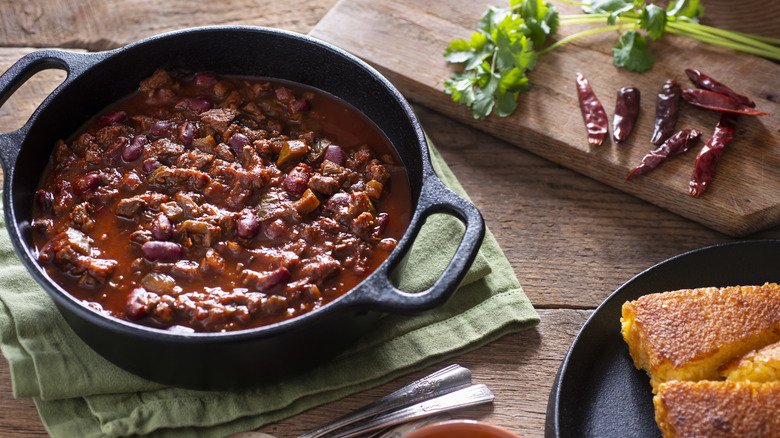Masa Harina Is The Secret To Thicker, More Flavorful Chili
Chili isn't really a soup — when you ladle it in your bowl, pile on the toppings, and get ready to take a bite, you're not going in for a slurp of liquid. You don't want something thin and insubstantial in your spoonful. The best chilis have a hearty thickness to them, brimming with a flavor and consistency that's often the result of a long cooking time on low heat. Sometimes, though, the hours of simmering aren't enough on their own to thicken a chili. Even after all that time, you still might take the lid off the pot to find that the liquid hasn't cooked down nearly enough and you're left with something soupy.
Of course, you could put the lid back on and continue to try to cook it down, but there's an easier (and more flavorful) solution: Break out the masa harina. This superfine corn flour acts as a thickening agent to add bulk to the dish when it's just a little too thin. And because it's made from corn and isn't the very neutral-tasting all-purpose flour or cornstarch, the masa harina imparts a slightly sweet corn flavor as it improves the consistency. The simple addition has a two-for-one benefit.
What is masa harina and why does it work for thickening?
Masa harina is a flour made from dried corn kernels that have been cooked and soaked in an alkaline solution, most often water with slaked lime (also called calcium hydroxide). The cooking and soaking is called the nixtamalization process, which has been a traditional practice in Mexico and Central America for centuries. There's evidence of people making masa dough as far back as 1500 to 1200 B.C. Nixtamalization makes the kernels easier to work with and mill, but it also has nutritional and taste value and actually changes the corn's chemical composition. The process increases the calcium content, dietary fiber, and iron.
To unlock the chili-thickening properties, you'll mix the flour with a little water to create a paste (this prevents the flour from forming clumps, which it would do if you sprinkled it directly into the chili). Adding the paste toward the end of the cooking process will alter the chili's consistency, thickening the liquids through starch gelatinization. The starch in flours is able to absorb water, with the starch granules swelling to create a viscous chili.
Masa harina's thickening powers will extend to any liquid dish, but it's the sweet corn flavor that makes it so ideal for chili. The taste pairs perfectly with chili's heat and spice, cutting through the rich, bright tomato sauce and savory meats and beans with something more earthy and almost buttery.
Keep the flour on hand
Once you've stocked up on masa harina for chili purposes (not to mention thickening any soups or stews that could do with a flavor boost), you're going to want to keep it on hand for your other culinary needs. Typically, masa dough's primary function is tortillas, tamales, empanadas, and pupusas, so this might be the time to dispense with storebought and start making your own homemade tortillas for delicious flavor and unbeatable freshness. Once you've mastered tortillas, masa harina also has great texture and taste when you're frying fish, chicken, vegetables, or anything else that could use a slightly crunchy, sweet corn-flavored breading.
You can swap your usual cornmeal for masa harina to get extra crispy cornbread crust — the fine grain and the intensified flavor from the nixtamalization process might just have you never going back to a cornmeal base. Since it's got such a distinctive flavor, baking with masa harina when you'd usually use a more neutral flour can pay off in delicious dividends, so it's worth trying it in cakes or cookies that have complementary flavor profiles or a bold taste that won't be overwhelmed by the nutty, buttery ingredient.


